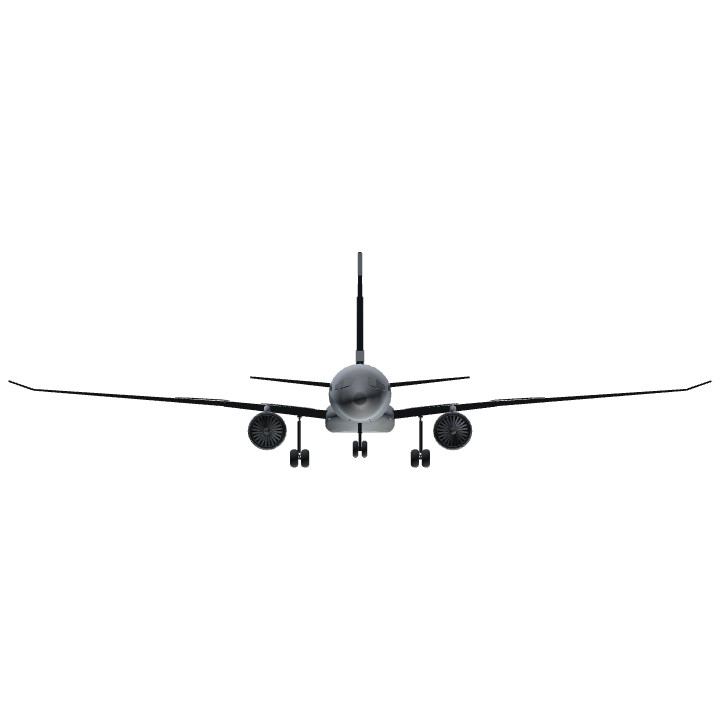Finally! After a few hours of no progress, I finally completed it! It's the Boeing 777-300ERF! I know that Swiss Airlines doesn't have a cargo selection but, I just didn't want to put windows on the sides. The WORST part of the build was the cockpit window! It was really nerve-wracking and I almost gave up. This is only my 4th build that has over 100 pieces and had difficulties trying to land it in it's test flights.
Instructions:
- AG1 Turns on the landing lights
- AG2 Activates the thrust reversers (control with trim up)
- AG3 Activates control of the spoilers (control with trim also)
Wiki:
The Boeing 777 is a wide-body airliner developed and manufactured by Boeing Commercial Airplanes. It is the world's largest twinjet and commonly referred to as the Triple Seven.[6][7] The 777 was designed to bridge the gap between Boeing's 767 and 747, and to replace older DC-10s or L-1011s. Developed in consultation with eight major airlines, with a first meeting in January 1990, the program was launched on October 14, 1990 with an order from United Airlines. The prototype was rolled out on April 9, 1994, and first flew on June 12, 1994. The 777 entered service with the launch customer, United Airlines, on June 7, 1995. Longer range variants were launched on February 29, 2000 and were first delivered on April 29, 2004.
It can accommodate up to ten abreast seating layout and has a typical 3-class capacity of 301 to 368 passengers, with a range of 5,240 to 8,555 nautical miles (9,700 to 15,840 km). It is recognizable for its large-diameter turbofan engines, six wheels on each main landing gear, fully circular fuselage cross-section,[8] and a blade-shaped tail cone.[9] It has fly-by-wire controls, a first for Boeing. It initially competed with Airbus A340 and McDonnell Douglas MD-11, both now out of production, and currently competes with the Airbus A330-300 and newer Airbus A350 XWB.
The original 777 with a maximum takeoff weight (MTOW) of 545,000–660,000 lb (247–299 t) was produced in two fuselage lengths: the initial -200 was followed by the extended-range 777-200ER in 1997; and the 33.25 ft (10.13 m) longer 777-300 in 1998. Those 777 Classics were powered with 77,200–98,000 lbf (343–436 kN) General Electric GE90, Pratt & Whitney PW4000, or Rolls-Royce Trent 800 engines.[10] The longer range 777-300ER with a MTOW of 766,000–775,000 lb (347–352 t) entered service in 2004, the ultra long-range 777-200LR in 2006, and the 777F freighter in 2009. These long haul variants feature 110,000–115,300 lbf (489–513 kN) GE90 engines and extended raked wingtips. In November 2013, Boeing announced the 777X development with the -8 and -9 variants, scheduled to enter service by 2020. The 777X features composite wings with folding wingtips and General Electric GE9X engines.
Thank you all for supporting me for the past few months!! Please Upvote!! :)
Specifications
General Characteristics
- Predecessor Boeing 777-300ERF
- Created On Windows
- Wingspan 133.2ft (40.6m)
- Length 136.2ft (41.5m)
- Height 40.6ft (12.4m)
- Empty Weight 65,976lbs (29,926kg)
- Loaded Weight 159,305lbs (72,259kg)
Performance
- Power/Weight Ratio 1.142
- Wing Loading 68.1lbs/ft2 (332.5kg/m2)
- Wing Area 2,339.1ft2 (217.3m2)
- Drag Points 28936
Parts
- Number of Parts 111
- Control Surfaces 14
- Performance Cost 877





lol there are 111 parts!!
@KorgonAviation No problem
@tsampoy thanks!
Nice!
Best plane yet